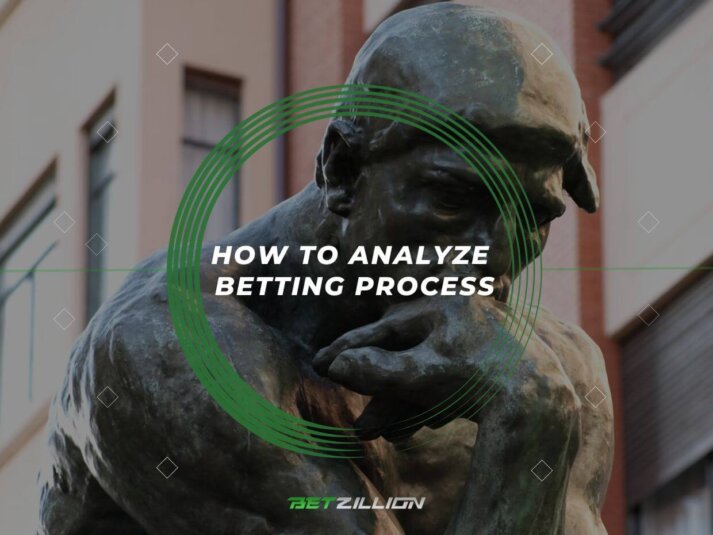This website uses cookies so that we can provide you with the best user experience possible. Cookie information is stored in your browser and performs functions such as recognising you when you return to our website and helping our team to understand which sections of the website you find most interesting and useful.
How to Evaluate Your Betting Process

Evaluating your betting process involves reviewing your strategies, decision-making, and betting outcomes. This helps you identify your strengths and weaknesses, and then consciously fine-tune your approach to make smarter and more profitable wagers over time.
Backtesting
Backtesting is the process of testing a betting strategy using historical data to see how it would have performed in the past. What you’re doing here is simple: pick a strategy, gather a list of past games where the strategy would have triggered a bet, simulate placing those stakes, and evaluate the results.
For example, your strategy might be to bet on an underdog EPL team to win or draw when the favorite has a tough Champions League match mid-week. To test this wagering process, you would compile a list of such fixtures from previous seasons, ideally 50 games or more, to get a reliable sample size. You then simulate your bets on those games and consider how profitable it would have been by reviewing performance metrics like win rate, ROI, total profit/loss, etc.
Using Historical Data
Like backtesting, you also use past results and odds in this evaluation process. However, while the focus in backtesting is strategy validation, the focus here is to generate insight. It involves reviewing historical data to assess how your strategy would have performed, but with an emphasis on understanding the patterns, learning from past decisions, and improving your future betting approach.
In other words, you are not necessarily trying to determine the most effective football betting system ever here. Instead, you’re analyzing past data to determine what would’ve been the smarter betting decisions and using that insight to make wiser bets in the future. However, you must also make sure to collect clean, complete, accurate, and unbiased data and avoid overfitting. You must also consider important factors like odds movement, betting trends, and market changes to get accurate insights.
Real Test With a Small Bankroll
Unlike other theoretical methods, this is when you test betting systems more practically. This evaluation process involves using a small bankroll and fixed-stake wagers to put your betting process into action on a small scale to see how it performs in real conditions. Every bet placed will then be documented and analyzed to help you identify the flaws or strengths in your system. Remember, the idea here isn’t to chase profits, but to see how well your strategy works.
Track and Analyze Results
This method involves carrying out a sports betting system’s detailed analysis by thoroughly reviewing your past bets. You collect detailed data on every bet you place, recording the date, sport, and event, type of wager, odds, stake amount, outcome, payout, expected value, etc. You can use spreadsheets like Excel, Google Sheets, or, if available, any dedicated tracking and analysis tools.
This detailed data tracking helps you identify patterns and gives you valuable insights about your betting processes. You get to find out whether you’re doing sports betting right and what you might be getting wrong, which will help you make smarter betting decisions going forward.
Key Metrics
Let’s discuss some important metrics to look out for when evaluating your betting process.
Average Implied Probability vs. Observed Win Rate
In sports betting, implied probability is the chance of winning as suggested by the odds. To calculate it:
- Implied Probability = (1/Odds) × 100
For example, with odds of 3.00, you’re betting on an outcome that the sportsbooks think has a 33.3% chance of panning out (1/3.00 X 100 = 33.3).
To find your average implied probability, convert each bet’s odds into implied probability, then average those percentages. For example, let’s say you use a Martingale system, where you double your stake after every loss and typically stick to bets with even odds (e.g., 2.00). In the martingale betting system, the mathematical analysis would result in an implied probability of 50% (1/2.00 × 100). This means that over time, you’ve consistently placed bets on events that the bookmakers think have a 50% chance of winning.
On the other hand, your observed win rate is the actual percentage of bets you’ve won:
- Win Rate = (Wins/Total Bets) × 100
So if you’ve won 25 out of 150 wagers, your betting process or system yields a 16.7% win rate. If your observed win rate is higher than your average implied probability, your edge is likely real, meaning your strategy or system works. If it’s lower, like in the example we considered, it likely means your system isn’t profitable in the long run.
Time/Yield Ratio
The Time/Yield ratio is how to test a betting system for its efficiency by comparing the time invested in it to the return it generates. To use this metric, you must track the amount of time you spent betting with a given strategy, including research, analysis, placing bets, monitoring results, etc., over a given period. Then divide your total profit over this period by the total time spent.
P-Value Analysis
The P-Value Analysis helps you determine whether your results come from a working system or if you’ve just been lucky. However, this metric can be complex when done manually, so using a free online P-value calculator is better.
To get your P-value, you must first calculate Standard Error (SE), which tells you how much your observed win rate fluctuates due to random chance. You also need to calculate a Z-score, which measures how much your actual win rate deviates from the expected win rate. If your P-value is less than 0.05, the result is statistically significant, which means your system is likely working and not just due to luck. If it is greater than 0.05, your results could be random, and your strategy may not be reliable in the long run.
Reevaluate and Refine
Even after you’ve done backtesting, followed test match betting rules, analyzed historical data, and so on, you still need to re-evaluate your process periodically. Re-evaluation will help you see if your strategy is still working as it should. If it isn’t, it becomes important to adjust and refine it for better results.
However, you must test each adjustment before you implement it fully. Do this with small wagers for a while and track the results. If they are desirable, you can then scale.
Final Words
Understanding the betting process meaning is all about discovering what truly works and what doesn’t. Whether by backtesting, historical data, real-money test, or any other method, it takes guesswork out of your wagering journey to a large extent and gives you a framework backed by data that helps you make smarter, more informed decisions over time.
Related articles
Chase Betting System
Fibonacci Betting System





